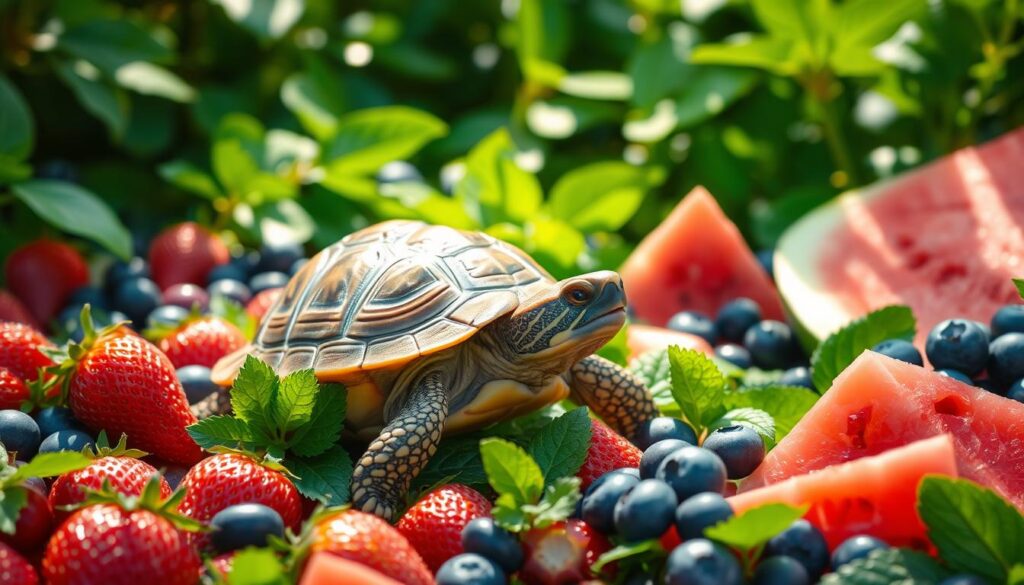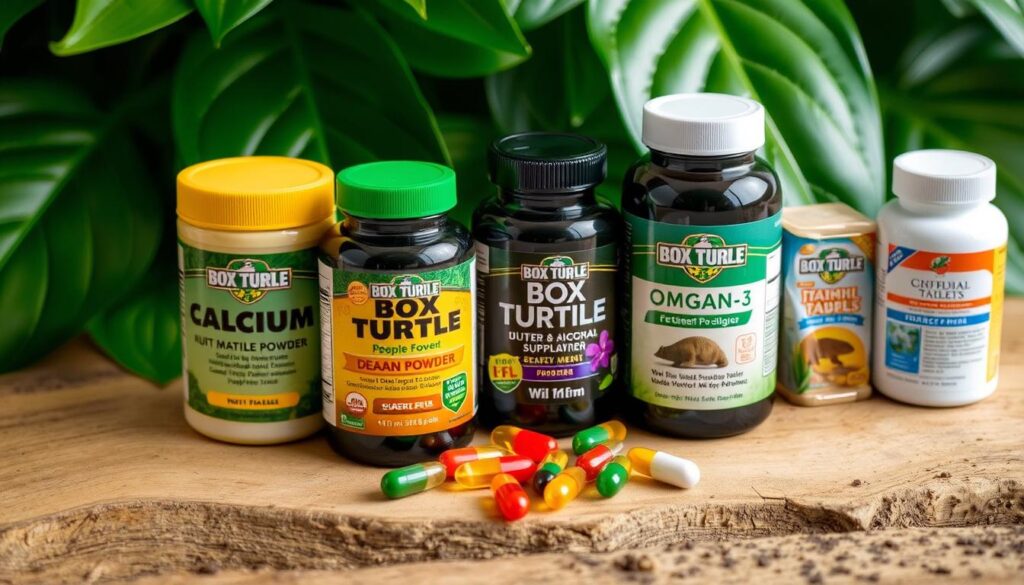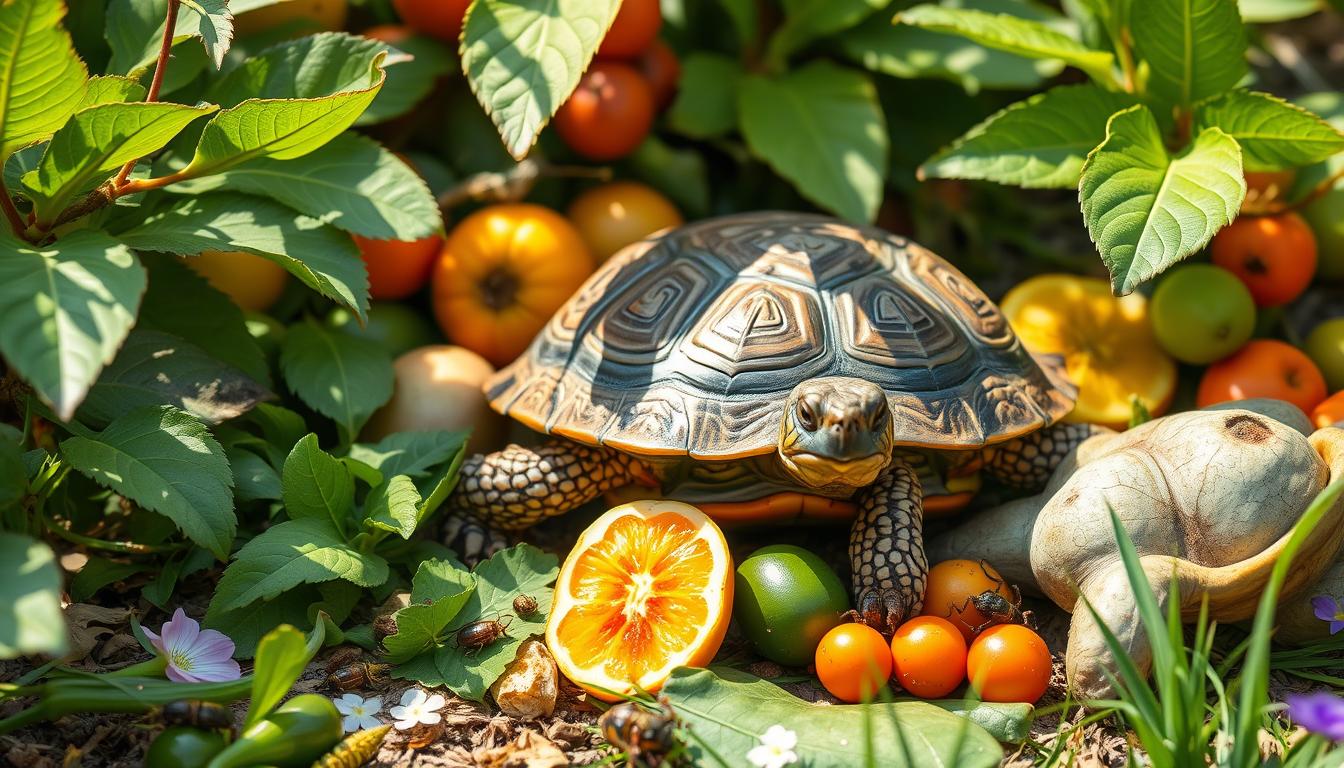I’ve always been fascinated by box turtles and their special diet needs. This guide is for both new pet owners and those curious about these creatures. We’ll cover what box turtles eat and how to give them a balanced diet.
We’ll talk about the diet differences between young and adult turtles. We’ll also explore essential vegetables and protein sources. Get ready to learn how to keep your box turtle happy, healthy, and thriving!
Table of Contents
Understanding Box Turtle Species and Their Natural Diet
Box turtles are a diverse group of terrestrial turtles. They have several distinct subspecies found in different regions. The four most common are the eastern, three-toed, Gulf Coast, and ornate box turtles.
Each subspecies has unique physical characteristics and natural habitats. These shape their dietary preferences.
Common Box Turtle Subspecies
- Eastern Box Turtle: Found in the eastern United States, these turtles have a high-domed shell and are known for their striking yellow and black patterns.
- Three-Toed Box Turtle: Inhabiting the central United States, these turtles have three toes on their hind feet and a more elongated shell shape.
- Gulf Coast Box Turtle: Native to the Gulf Coast region, these turtles have a flatter, more oval-shaped shell and can be identified by their brown and yellow patterns.
- Ornate Box Turtle: Found in the central Plains states, these turtles are characterized by their intricate, radiating patterns on their shells.
Wild Feeding Habits
In their natural habitats, box turtles are opportunistic omnivores. They forage for a diverse array of plant and animal matter. Their sharp eyes and keen sense of smell help them locate food sources.
They eat fruits, flowers, leaves, insects, worms, snails, and small vertebrates. The dietary preferences of box turtles often shift as they age. Young turtles are more carnivorous, while adults become increasingly herbivorous.
Dietary Differences Between Young and Adult Turtles
Young box turtles, during their first year of life, tend to be primarily carnivorous. They consume a higher proportion of proteins from insects, worms, and small vertebrates. As they mature, box turtles gradually transition to a more herbivorous diet.
Adult turtles consume a balanced mix of plant matter, such as leafy greens, vegetables, and fruits. They also eat occasional animal protein sources.
“Box turtles are fascinating creatures, with a diverse range of subspecies and natural feeding habits that have evolved to suit their unique environments.”
What Do Box Turtles Eat in Captivity
When you care for a box turtle at home, it’s important to give them a balanced diet. Box turtles eat both plants and animals. They need about 80-90% veggies and flowers, and 10-20% fruits and proteins.
The captive box turtle diet should have dark leafy greens, colorful veggies, and fruits now and then. Good choices are kale, collard greens, carrots, bell peppers, and berries or melon. Adding box turtle food like turtle pellets is also good for them.
For animal proteins, box turtles can have insects, worms, and lean cooked meats. But, these should only be a small part of their diet. This keeps their diet balanced.
It’s also key to feed them regularly. Adults can eat every 2-3 days, and young ones might need to eat more often. It’s important to control how much they eat to keep them healthy.
Keeping a varied and balanced captive box turtle diet is vital for their health. By following the right diet and talking to a vet, your box turtle can live a long and happy life.
Essential Vegetables for Box Turtles
Box turtles need a mix of vegetables in their diet. Dark leafy greens should be the main part of their meals. These greens give them important nutrients and fiber. Good choices include collard greens, mustard greens, dandelion greens, and kale.
Dark Leafy Greens
- Collard greens
- Mustard greens
- Dandelion greens
- Kale
Colorful Vegetables
Box turtles also benefit from colorful veggies like bell peppers, squash, and carrots. These add more vitamins, minerals, and antioxidants to their diet.
Vegetables to Avoid
Some veggies are not good for box turtles. Avoid giving them iceberg lettuce and celery because they’re not very nutritious. Also, veggies with a lot of oxalates, like Swiss chard and spinach, can block calcium absorption. So, feed them sparingly.
| Recommended Vegetables | Vegetables to Avoid |
|---|---|
|
|
By offering a variety of healthy veggies, you can make sure your box turtle eats well. This supports their growth and health.
Fruits as Part of Box Turtle Diet
Box turtles love fruits, but they should only eat them less than 10% of the time. Good fruits for them are apples, pears, bananas, grapes, melons, and berries. Fruits like figs, apricots, and dates are also good because they have a lot of calcium.
But, it’s important not to give them too much fruit. Fruit has a lot of sugar and not as much nutrition as veggies. Eating too much fruit can cause problems like obesity and bone disease. So, it’s better to give them more veggies and less fruit.
| Suitable Fruits for Box Turtles | Fruits to Avoid |
|---|---|
|
|
For a box turtle to be healthy, they need a balanced diet. Fruits can be a fun treat sometimes, but most of their food should be veggies. This helps them stay healthy and live a long life.

“A balanced diet is the foundation for a thriving box turtle. While fruits can be a delightful addition, they should be offered in moderation to maintain optimal health.”
Protein Sources and Live Food Options
Animal-based protein sources are key for your box turtle’s diet. They need a mix of plant and protein-rich foods to stay healthy.
Insects and Invertebrates
Insects and invertebrates are great live food for box turtles. Crickets, mealworms, and earthworms are good choices. You can find them at pet stores or from reptile breeders. These foods give your turtle box turtle protein and let them hunt naturally.
Other Protein Sources
Box turtles also like other animal proteins. Small amounts of cooked lean meats, hard-boiled eggs, and moistened dog food are good. But, give these foods in small amounts to keep the diet balanced.
Commercial Protein Options
Commercial reptile pellets are a great, easy protein source for box turtle protein. They are made to give your turtle all the nutrients they need. Always choose high-quality pellets from trusted brands.
It’s important to get live food from safe sources. This helps avoid harmful contaminants. A varied diet is essential for your turtle’s health and happiness.
“Proper feeding is essential for the long-term health and well-being of box turtles. A balanced diet that includes both plant-based and animal-based nutrients is crucial for their optimal development and longevity.”
| Protein Source | Recommended Portion | Benefits |
|---|---|---|
| Crickets | 2-3 per feeding | High in protein, calcium, and other essential nutrients |
| Mealworms | 3-5 per feeding | Provide a good source of protein and fat |
| Earthworms | 1-2 per feeding | Rich in nutrients and easy for box turtles to digest |
| Cooked Lean Meat | Small, bite-sized pieces | Offer additional protein and nutrients |
| Hard-Boiled Egg | Small, bite-sized pieces | Provides high-quality protein and other essential nutrients |
| Commercial Pellets | As directed on packaging | Balanced nutrition for captive box turtles |
Calcium and Vitamin Requirements
Keeping your box turtle’s calcium and vitamin levels right is key to their health. These nutrients help with bone growth, shell development, and keeping them full of energy.
Box turtles need more calcium than phosphorus. A good ratio is between 1.5:1 and 2:1. Your vet might suggest adding a calcium powder to their food 2-3 times a week.
Box turtles also need vitamin A in their diet. A lack of it is common but can be avoided with a varied diet of fresh fruits and veggies. Turtles that stay indoors might need extra vitamin D3 to stay healthy.
Adding a reptile multivitamin-mineral powder once a week is also good. It makes sure they get all the vitamins and minerals they need to stay healthy.
“Maintaining the proper calcium and vitamin levels in a box turtle’s diet is essential for their overall health and longevity.”

By watching what your box turtle eats and adding the right box turtle supplements, they can live a long, happy life. It’s important to keep an eye on their diet to ensure they stay healthy.
Feeding Schedule and Portion Control
It’s key to keep a good feeding schedule and control portions for your box turtle’s health. How often and how much you feed depends on your turtle’s age and stage of life.
Juvenile Feeding Guidelines
Baby and young box turtles need to eat more often because they grow fast. Hatchlings should eat twice a day, and young ones once a day. Feed them an amount that’s about the size of their head or a bit bigger.
Adult Feeding Recommendations
As box turtles get older, they eat less. Adults can eat every other day or 3-4 times a week. Feed them a bit less than their head size. Too much food can cause obesity and health problems, so watch their portions closely.
Always talk to a vet to find out the best feeding schedule and amounts for your box turtle. Good feeding habits are vital for your turtle’s health and happiness in captivity.
“An efficient filtration system is crucial for maintaining clean and clear water in a pond where turtles reside.”
Water Requirements and Hydration
Keeping your box turtle hydrated is key to their health. They need fresh, clean water for drinking and soaking. Make sure they have a shallow dish that’s easy to reach. Change the water daily and clean the bowl often.
Also, mist your box turtle with water a few times a week. This helps prevent dehydration, especially when they’re active or in dry places. If your turtle is hard to get to drink, try soaking their favorite greens first.
Proper box turtle hydration is vital for digestion, waste, and temperature control. Dehydration can cause serious health problems. So, always keep a steady supply of water for box turtles.
“Freshwater aquatic turtles like the red-eared slider should live in an aquarium that is ⅔ water and ⅓ dry basking area.”
Box turtles may not live in water like sliders, but they still need plenty of hydration. By following these tips, you can keep your box turtle happy, healthy, and well-hydrated.
Safe Food Preparation and Handling
Keeping your pet box turtle healthy means giving them safe, nutritious food. Here are some important steps to follow:
- Thoroughly wash all fruits and vegetables before feeding to remove any residual pesticides or contaminants.
- Chop the food into appropriately sized pieces, considering your turtle’s size and feeding capabilities.
- Avoid feeding directly on loose substrate, as this can lead to accidental ingestion and potential gastrointestinal issues.
- Use a flat, rough stone as a feeding surface to help wear down your turtle’s beak and maintain its natural shape.
- Always wash your hands thoroughly after handling your turtle or its food to prevent the spread of Salmonella bacteria, which box turtles can potentially carry.
By following these simple steps, you can keep your box turtle safe and healthy. Remember, a well-cared-for box turtle can live up to 100 years. So, start with good preparing box turtle food habits right away.
“Proper food preparation and handling is a crucial aspect of providing a healthy and enriching diet for your box turtle.”
Foods to Avoid and Common Dietary Mistakes
As a responsible box turtle owner, knowing what foods and plants are toxic is key. Avoid giving your turtle ornamental or houseplants, as they can be harmful. Also, cat and dog food is bad because it has too much phosphorus, which can upset your turtle’s health balance.
Toxic Foods and Plants
Fruits should be given in small amounts because they are high in sugar. This can cause obesity and upset your turtle’s gut. Also, avoid plants like spinach and beet greens because they can block calcium absorption. Wild insects caught outside can also be bad, as they might have pesticides.
Inappropriate Commercial Foods
While turtle pellets are easy, they shouldn’t be all your turtle eats. A good diet includes fresh veggies, fruits, and proteins. This mix is vital for your turtle’s health and happiness. By avoiding these diet mistakes, you can help your box turtle live well in captivity.

